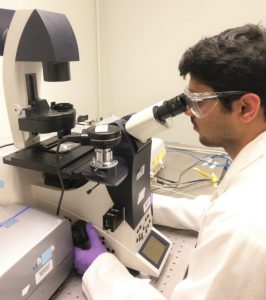Study Explores How Five Surfactants Affect Oil Biodegradation
– MAY 14, 2019
Scientists compared how different surfactants affect bacterial adhesion to oil droplets (20−60 μm), which is necessary for biodegradation. The surfactants tested were dioctyl sodium sulfosuccinate (DOSS, a COREXIT component), dibutyl sodium sulfosuccinate (DBSS), dicyclohexyl sodium sulfosuccinate (DCHSS), cetyltrimethylammonium bromide (CTAB), and Tween 20. For all surfactants, increasing the surfactant concentration reduced bacterial adhesion to oil drops. Bacteria adhered in slightly greater areal densities on small droplets (20 μm), suggesting that electrostatics may affect the number of bacteria that adhere to oil. Negatively-charged interfaces associated with DOSS, DBSS, and DCHSS had fewer bacteria adhering to oil drops compared to positively- and neutrally-charged interfaces associated with CTAB or Tween 20. These results suggest that certain surfactants may have competing effects on bacterial adhesion and, hence, degradation: increased adhesion due to decreased droplet size contrasts with reduced adhesion due to lower oil-water interfacial tension.
The researchers published their findings in Langmuir: Adhesion of Marinobacter hydrocarbonoclasticus to surfactant-decorated dodecane droplets.
Chemical dispersants, a mixture of emulsifiers (surfactants) and solvents, breakup oil slicks into smaller droplets and enhance the oil’s bioavailability by increasing the surface area upon which oil-degrading bacteria can adhere. However, the curvature of the interface between oil droplets and water alters the area available to surfactants, complicating predictions of bacterial adsorption.
To better understand bacterial adhesion processes (using Marinobacter hydrocarbonoclasticus, a marine organism implicated in biodegradation) with different surfactants, the team prepared dodecane oil-in-water emulsions using co-flow microfluidic devices with droplet diameters observed during Deepwater Horizon. Using 3-D fluorescence images taken over times of up to three hours by a confocal microscope, the team counted the number of bacteria that adhered to the interface.
The authors noted that their laboratory experiments represent simplified conditions compared to actual marine biodegradation and that the results should be considered for optimal (i.e. minimal) application of surfactants or dispersants early in an oil spill scenario. For longer time scales, oil-metabolizing bacteria may be able to grow on the oil-water interface and continue modifying interfacial tension, further complicating predictions of oil biodegradation. They suggest that future research investigate how growth, bacterial exudates, motility, flow, and organic matter affect bacterial adhesion to the oil-water interface.
The study results have broader implications for technological processes involving bacterial interactions with oil-water interfaces. For example, microfluidically-produced droplets are used for pathogen detection, antibiotic susceptibility, biotechnological selection, and wastewater treatment.
Data are publicly available through the Gulf of Mexico Research Initiative Information and Data Cooperative (GRIIDC) at doi:10.7266/N7CR5RZZ and doi:10.7266/n7-dhkx-yh57.
The study’s authors are Narendra K. Dewangan and Jacinta C. Conrad.
By Nilde Maggie Dannreuther and Stephanie Ellis. Contact maggied@ngi.msstate.edu with questions or comments.
************
This research was made possible in part by a grant from the Gulf of Mexico Research Initiative (GoMRI) to the University of Houston Department of Chemical and Biomolecular Engineering for their project Role of Microbial Motility for Degradation of Dispersed Oil. Other funding sources included the Welch Foundation (E-1869).
The Gulf of Mexico Research Initiative (GoMRI) is a 10-year independent research program established to study the effect, and the potential associated impact, of hydrocarbon releases on the environment and public health, as well as to develop improved spill mitigation, oil detection, characterization and remediation technologies. An independent and academic 20-member Research Board makes the funding and research direction decisions to ensure the intellectual quality, effectiveness and academic independence of the GoMRI research. All research data, findings and publications will be made publicly available. The program was established through a $500 million financial commitment from BP. For more information, visit https://gulfresearchinitiative.org/.
© Copyright 2010-2019 Gulf of Mexico Research Initiative (GoMRI) – All Rights Reserved. Redistribution is encouraged with acknowledgement to the Gulf of Mexico Research Initiative (GoMRI). Please credit images and/or videos as done in each article. Questions? Contact web-content editor Nilde “Maggie” Dannreuther, Northern Gulf Institute, Mississippi State University (maggied@ngi.msstate.edu).






